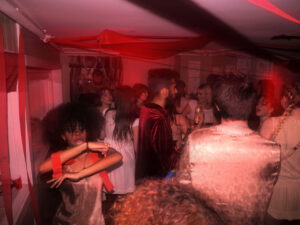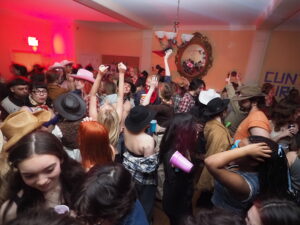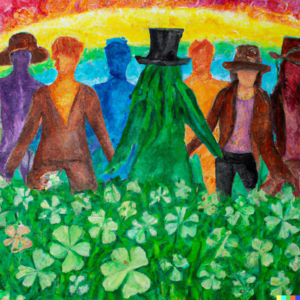
On Bennington campus, the ratio of students to individual species of tree is ten to one. Anonymity is scant. No matter how much foliage there is to shade us, we have to invent other things to hide behind. Layers of irony stack so high they basically blur into nothing. “Bullshitting” seems to run deeper here than any comparable liberal arts college, arguably so far that it circles back to authenticity. All of this to say, the issue of persona at Bennington (vs. the Bennington Persona) is wound so tightly around itself, it seems unbreachable. With the help of some of my fellow posers, I will attempt to unravel it anyway.
Of all the promises Bennington makes to its students, the self-directed education model may hold up the best. For some, it’s an art school; for others, it’s Donna Tartt’s Hampden College. Many of us are not in college so much as summer camp. The experience is what you make of it. Yet, perhaps due to the tight quarters, a homogeneity has emerged. This manifests itself in a verbal and visual language that is easy to pick up, once you identify the elements.
Step one: Adopt the vocabulary
Read any liberal arts discussion board and you’ll find a similar dialect. These are a few terms gathered from Bennington students and myself:
1. Nu·ance (/ˈno͞oˌäns/) noun: a subtle difference in or shade of meaning, expression, or sound.
2. Du·al·i·ty (/do͞oˈalədē/) noun: an instance of opposition or contrast between two concepts or two aspects of something. Apply whenever you think something might be nuanced.
3. In·ter·sec·tion·al·i·ty (/ˌin(t)ərˌsekSHəˈnalədē/) noun: the interconnected nature of social categorizations such as race, class, and gender as they apply to a given individual or group, regarded as creating overlapping and interdependent systems of discrimination or disadvantage. Apply whenever you think something might be nuanced.
4. Jux·ta·po·si·tion (/ˌjəkstəpəˈziSHən/) noun: the fact of two things being seen or placed close together with contrasting effect. Apply when two things either do, or might, happen at once.
5. Ar·chi·val (/ˌärˈkīvl/) adjective: relating to an archive of historical records or electronic documents. Apply when something looks old, or when it looks modern but someone in the future would think it looks old (because of time).
6. Aut·o·fic·tion (/ ˈɔ toʊˌfɪk ʃən /) noun: a genre of novel or short story whose narrator or protagonist is understood to be the author, and which explores the author’s real-life story using the techniques and devices of fiction. Apply when an artwork is fictional, but was technically made by a person.
7. E·phem·er·a (/əˈfem(ə)rə/) noun: items of collectible memorabilia, typically written or printed ones, that were originally expected to have only short-term usefulness or popularity. Apply when you see an object.
7. Lim·i·nal (/ˈlimənəl/) adjective: of, relating to, or being an intermediate state, phase, or condition. Apply whenever you think something might be nuanced.
Step two: Assemble your references
An important part of establishing your persona is having good references on deck. If you curate the right references, peers and faculty will be able to ascertain a certain vibe from you without digging any deeper. Artists like Sofia Coppola and Wong Kar-wai are too basic or mainstream, and mentioning Wes Anderson might be the biggest faux-pas you can make. Common references are Marina Abramović, Cindy Sherman, and Hilma af Klint, which indicate some knowledge of the “art world” but no individual tastes. You have to have your own favorite artist, director, writer, novel, film (but avoid saying “film”), which are yours alone. They should be obscure enough so no one can question your knowledge or reasoning, but inspire the sentence “the name sounds familiar” so everyone can assume you have taste without doubting their own.
Alternatively, you can go full mainstream. No La La Land and, I repeat, NO WES ANDERSON, but a commercial horror movie, 2010s blockbuster, or something so-bad-it’s-good, will circle back around to being cool. Just make sure to mention it’s unironic, even if it absolutely is. “You subvert the narrative by saying that Teen Beach Movie is your favorite movie, but you also come off quirky and cool, like you have an edge to you. But someone asked me what my favorite movie is one time and I said Silver Linings Playbook… you can’t like Hollywood,” says junior literature student Toulmin Jahncke. The example of a Disney Channel movie works as an identifier for a cool but down-to-earth person, maybe even a “hot take”, while something more artistic but still coming from Hollywood lands uncomfortably in between the two extremes of narrative trash and experimental art. In a year or two, liking Wes Anderson will be so cliche that it’s subversive, but we’re not quite there yet.
As for literature, Jahncke continues, “I’m sorry my favorite book is [by] Jane Austen. This goes for most disciplines, I think, but there’s an emphasis on, the more tragic the work, the more profound it is. [Austen is] not intelligent because it’s not sad, but if you take something like A Little Life, that’s trauma porn. You’re walking into that uncanny valley of what’s appropriate to have as a favorite or not.” Note: uncanny valley is another phrase worth adding to the dictionary.
Step three: Make the work
Since the Bennington community is concentrated on one small surface, making original work takes a lot of creativity and, at times, recycling. I sit with Alma Reiss-Navarre, who is in their fourth year studying visual arts, in the sculpture installation room after their critique. A mass of blue shirts from the costume shop hang from the ceiling with different videos projected onto them. “I feel like we don’t see a lot of blue at Bennington,” they remark. The shirts would end up being worn by their dancers at the Martha Hill show. We mess around with the projector. Every angle I try, they say they’ve already done. A video comes on of Reiss–Navarre dancing with printed sheets in the woods which I filmed for them two years ago, and ultimately used for my own sound design project later that year. It was one of the more Bennington-esque projects I’ve made: abstract sounds, interpretive dance, and obnoxious color choices made in post. This sparks a conversation with Reiss-Navarre about the visual feedback loop we get stuck in at Bennington. “I think everybody has this idea of Bennington based on the colors we see everyday because we’re here every day. There’s the brick red, Barn red, all of the weird blues and grays in the buildings, and the intense green everywhere. You see the exact same thing every day.” Perhaps this is why many Bennington students gravitate towards black and white imagery. Removing color information adds a layer of obscurity to a hyper-familiar image our eyes are sick of. It’s also less work, as it’s inherently artistic-looking. “Any time color comes up people just have to mention nostalgia. I’ve gotten ‘I think the color, it just gives this childlike, playful thing… it’s kind of nostalgia for childhood’ so many times,” says Reiss-Navarre.
Every visual art student, especially in video or photography, seems to reach a critical point in their work where they can no longer use Bennington as a backdrop. Seeing Jennings or the Blue Trail in crit can become like nails on a chalkboard. Many will shoot off campus, otherwise try to hide the fact that they’re shooting here. In a way, this issue extends to literature. Bennington may have inspired many great authors, but has the well finally run dry? We live in an environment that has been committed to prose and poetry dozens of times over. With a lack of room for imagination, the work has to get even more personal. Toulmin Jahncke remarks on the rise of autofiction, “People end up just being like, ‘this is directly my life and the person I had sex with and everything that happened between us and you are all gonna hear about it in workshop.’” She continues, “I don’t think that’s always a bad thing. Nothing is entirely fictional. But, I know exactly who you’re talking about.” Gossip proliferates so quickly here that by the time you make art about your experience, or based on your friends’ experiences, we’ve all already heard about it at last week’s Sunday brunch. “That is really one of the voids–one of the disconnects here, just pretending that you don’t know stuff all the time,” says Alma Reiss-Navarre. “You don’t need to call your friends ‘my friends.’ I know where you live, who your roommate is, what your entire history at Bennington is, and who your friends are.”





Be First to Comment